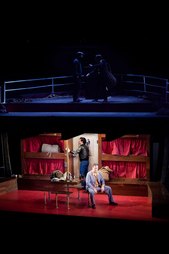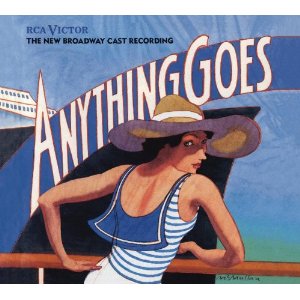SITE GUIDE
SEARCH
REVIEWS
REVIEW ARCHIVES
ADVERTISING AT CURTAINUP
FEATURES
NEWS
Etcetera and
Short Term Listings
LISTINGS
Broadway
Off-Broadway
NYC Restaurants
BOOKS and CDs
OTHER PLACES
Berkshires
London
California
New Jersey
DC
Philadelphia
Elsewhere
QUOTES
TKTS
PLAYWRIGHTS' ALBUMS
LETTERS TO EDITOR
FILM
LINKS
MISCELLANEOUS
Free Updates
Masthead
A CurtainUp Review
Under the Whaleback
Cassidy
| "Old Father Neptune's been nippin' at my ass for fifty years."—Cassidy
|

Brian Ratcliffe, Pearce Bunting
(Photo by Alexander Iziliaev) |
This story conjures the large commercial fishing boats that for years filled the harbor of the once flourishing, but lately declining town. The fishing industry collapsed after the Cod Wars in '76, suddenly, and portentously in this case, leaving the town's young men, who had been destined for that perilous occupation, with bleak prospects for finding steady work.
You never know what director Blanka Zizka may have up her sleeve. The Wilma's stage seems to have disappeared. In its place is the bow of a large sidewinder trawler. However, no active display of the kind of work involved on a commercial fishing boat will take place, because the play's action transpires in a cutaway of the crew's quarters located under the whaleback (that is, down the companionway and inside the trawler's raised bow).
Except for the underlying and ever-present understanding that they are at the mercy of the sea, the men's conversation in their berth under the whaleback runs much like that of lads in a pub-carrying on, complaining, and cracking jokes at each others' expense. They weigh in, for instance, as someone plans to marry a woman he doesn't love, and they extol the exploits of a local character.
The bonds among the men, along with the strong sense of enclosure during a sea journey, prick memories of other sailors like the men in the bunks and benches of the tramp steamer in Eugene O'Neil's sad, intimate play, Bound East for Cardiff. And the larger picture of the town's steady loss of men going down to the boats and many ultimately to the deep, brings hovering associations with Synge's Riders to the Sea.
To the beautiful, heavy tradition of sea plays Richard Bean contributes more heartache, mixed with a good measure of dry and earthy comedy. The tragedy, full of undercurrents of anxiety and roguish laughs, develops over a space of time; its three acts operate like short plays connected by generational links. Each act presents a different time, and in each the same basic set represents a different vessel.
At the start it's 1965 and we meet Cassidy, an outrageous drunk and fisherman's legend in his own time. He passes on knowledge and a package to a fresh faced young crew member, Darrell, who has just come aboard. The second act, set in 1972, accomplishes a few things: It reveals that tragedy already has made an appearance, discloses information about men on the sidewinder, and looks forward to their plans for the future-- just as another massive storm hits.
By the third act, set in 2002, the boat has become an emasculated museum exhibit with sanitized audiotaped commentary presided over by an older Darrel. The action quickly goes over the top, as a young man with a mission arrives, bringing tension to new heights, or some might say to new lows. The radical off-putting game-changer is slightly reminiscent of the "Stuck in the Middle With You" scenario in Reservoir Dogs. The pressure drops at the end.
The looming, strong visual presence of set designer Matt Saunders' boat dominates the space, at times listing dangerously, aided by hidden hydraulics. Odd, though, that in a seafaring play there are no lighting configurations or projections that suggest the sea, and there's not a drop of actual water. The only representation of water is aural, carried through Daniel Perelstein's potent sound design.
Almost a century ago Eugene O'Neill explored the use of a fog horn to good effect in Bound East for Cardiff . You could say theatrical sound has seen some development since then. In Under the Whaleback, background sounds of wild wind, roaring sea, and assertive yet plaintive horns emerge in the dark. Rising ever more dramatically, the ominous clamor of crashing waves converges with a sound suggesting loud powerful wind, and grows so enormous that it envelops the boat and all the people in the theater in dark, mind-shaking, frightening noise.
All the actors in this Wilma production are quite extraordinary. Notably, Pearce Bunting was born to be Cassidy. Keith Conallen plays key roles of Norman and Pat with a vengeance. Philadelphia audiences have seen Conallen's work in several productions in recent years and he just gets more amazing all the time. H. Michael Walls infuses his role of Bill, an older hand, with loads of appealing personality. The whole cast, which includes Brian Ratcliffe, Ed Swidey, Ross Beschler, and Gaby Bradbury, is completely engaged in the piece, and their new unaccustomed accents are believable and blend right in without drawing undue attention. That's an accomplishment. Kudos to the voice and dialect coaches.
Under the Whaleback sucks you into a theater experience you won't soon forget, with ties to the past and warnings for the future. It's a story of Hull, and by extension a tale of many towns left behind with populations set adrift, forced to face vanished prospects. Life in the trawlers was dangerous, but it was honest labor. Lives lost at sea are tragic. So are lives with no future.
|
Under the Whaleback
by Richard Bean
Directed by Blanka Zizka Cast: Ross Beschler, Gaby Bradbury, Pearce Bunting, Keith Conallen, Brian Ratcliffe, Ed Swidey, H. Michael Walls Scenic Design: Matt Saunders Lighting Design: Allen Hahn Costume Design: Oana Botez Sound Design: Daniel Perelstein March 6- April 7, 2013 2 hrs and 15 minutes with one 15 min intermission Reviewed by Kathryn Osenlund based on 03/14 performance. Wilma Theater |
| REVIEW FEEDBACK Highlight one of the responses below and click "copy" or"CTRL+C"
Paste the highlighted text into the subject line (CTRL+ V): Feel free to add detailed comments in the body of the email. . .also the names and emails of any friends to whom you'd like us to forward a copy of this review. Visit Curtainup's Blog Annex For a feed to reviews and features as they are posted add http://curtainupnewlinks.blogspot.com to your reader Curtainup at Facebook . . . Curtainup at Twitter Subscribe to our FREE email updates: E-mail: esommer@curtainup.comesommer@curtainup.com put SUBSCRIBE CURTAINUP EMAIL UPDATE in the subject line and your full name and email address in the body of the message. If you can spare a minute, tell us how you came to CurtainUp and from what part of the country. |

Slings & Arrows- view 1st episode free
 Anything Goes Cast Recording
Anything Goes Cast RecordingOur review of the show
 Book of Mormon -CD
Book of Mormon -CDOur review of the show

